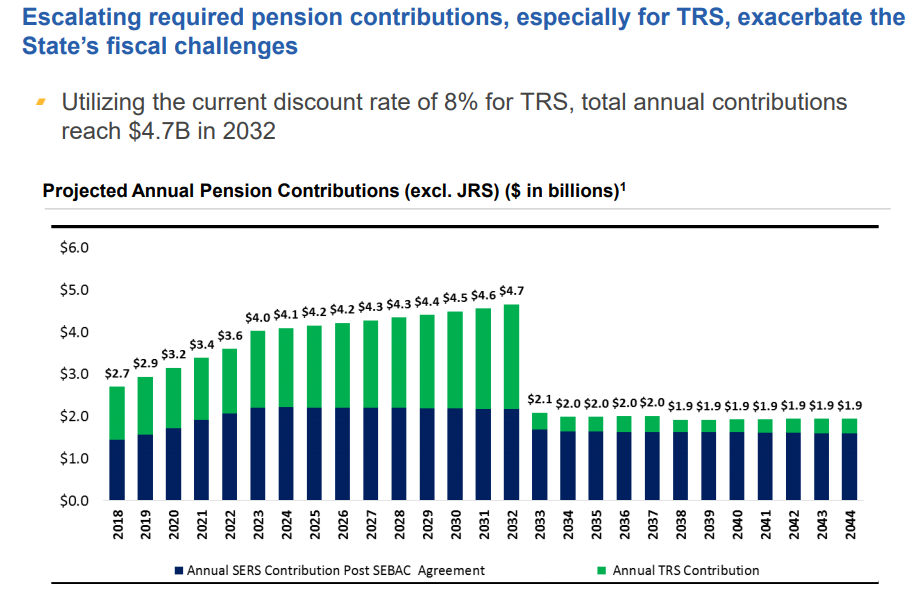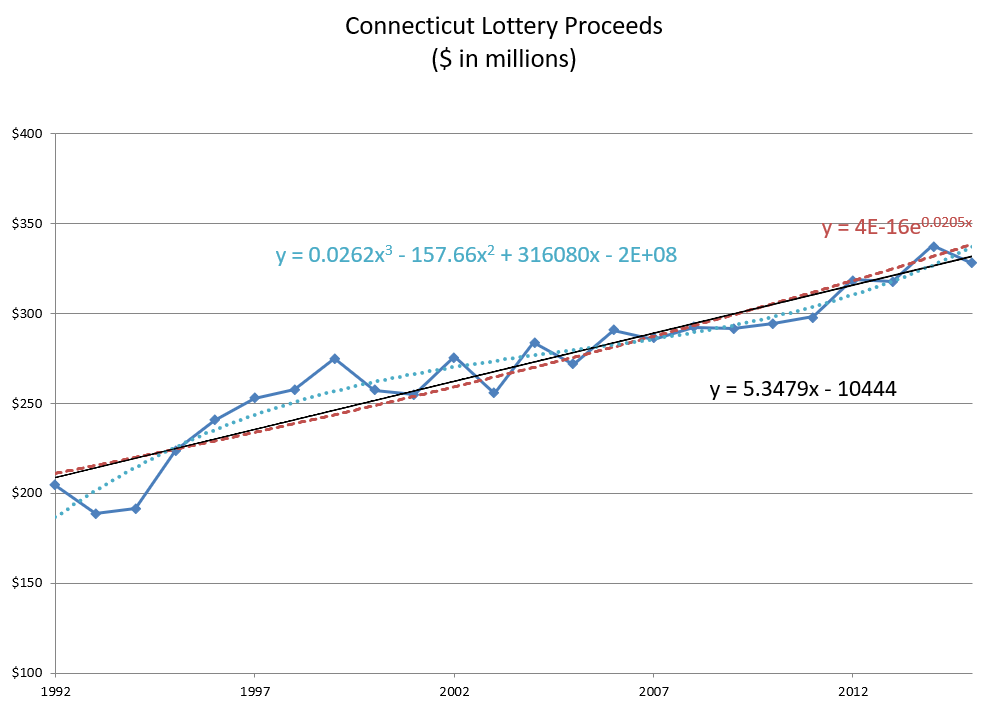The Fiscal State of Connecticut: Totally Screwed
by meep
And that’s the “aspirational” take.
Here’s the short version of the story. Back in December, the governor of Connecticut called forth a Commission to check out exactly how screwed Connecticut is in its finances.
March 1, they issued a draft report.
Conclusion: CT is very, very screwed.
TOP FINDINGS: CONNECTICUT FINANCES SUCK
Here are the top findings in the report [page 6]:
While neighboring states and the United States as a whole have economies that are growing, our economy is shrinking—it is actually smaller than it was in 2004;
We are losing ground on numerous key measures of competitiveness: tax climate, business climate, transportation quality, vitality of cities, and more;
We are facing ongoing budget deficits of $2 billion – $3 billion in FY 2020 and beyond, growing by $500 million per year.
They don’t give a comparison in the findings, but the general fund revenue is about $18 billion, so $1 or $2 billion deficits are huge.
TOP RECOMMENDATIONS: NIBBLING AT THE EDGES
On page 7, they give 10 recommendations. I’m not excerpting them all… here are my top items:
1. Enact a revenue neutral rebalancing of state taxes (which becomes revenue positive when coupled with economic growth) that reduces income taxes in every bracket, selectively raises taxes on business, raises the sales tax rate by less than 1%, cuts exemptions and exclusions from all taxes by 14%, and eliminates the dwindling estate and gift taxes.
2. Raise the gas tax to fund transportation projects and produce a plan for eventual implementation of electronic tolls.
…..
4. Have the legislature assume the responsibility to define state employee fringe benefits by removing them from collective bargaining for new contracts.
….
6. Develop and implement a plan to cut $1 billion out of annual operating expenses.7. Reform the Teachers’ Retirement System to lower costs and to make it sustainable by paying down unfunded liabilities.
Let’s just address these in order.
Shifting from income taxes to business taxes will just run more companies out of the state. Way to go.
Odd about the estate/gift tax, but I don’t care enough to dig into that one.
But raising the sales tax, and gas taxes, means people like me, who have a lot of flexibility in choosing whether to shop in NY or CT, will stick more to NY. I buy gas in CT as it has lower gas taxes. It would be very easy for me to shift which gas stations I would go to.
But then tolls… ugh. Yeah, between NY & CT I, personally, am going to get super-screwed.
I would love to see them implement #4, but I rather imagine that will be extremely contentious. The “TAX THE RICH KILL THE RICH” state union members will not take that one lying down… but I’m not sure they’ve really got much political power any more. When the whole point of reduction of income taxes is to keep from running out the super-rich, obviously the super-rich have the upper hand.
Reduce operational expenses by $1 billion? Does that include the operational cost of pension benefits? I would really like to see this one, and I can see this being a campaign issue for candidates up and down the ballot in Connecticut this year, from legislature to governor. I will likely be very closely watching this gubernatorial race this year, because I’m in total despair over New York.
And finally… the pensions? Hmmm, that requires its own section.
THE GIVEAWAY: ASPIRING TO PAY THE PENSIONS
This is the true giveaway as to how screwed Connecticut is. I thank Gordon Hamlin, Jr., for pointing out the following passages starting on page 48 of the report:
The Teachers’ Retirement System (TRS): Teachers’ pension benefits, and the state funding required to pay them, are putting an unsustainable burden on the state’s budget. With the assumption of full funding by 2032, the state will be required to contribute $2.7 billion to the TRS in that year, implying an annual growth rate in the contribution of more than 6%.
…..
To reach an aspirational goal of 75%, a pay down of $12 billion is required.
So – there are two things here.
They are moving the target from 100% to 75% — and they’re calling 75% “aspirational”.
Oh, and they repeat this aspirational on the next page… immediately followed by this:
To reach an aspirational goal of 75% funding ratio, a pay down of $17.3 billion is required (pension experts would argue that a higher goal of 80% would be preferable).
I WOULD ARGUE THAT FULLY FUNDING THE PENSIONS IS PREFERABLE
Okay, more calmly now, this is the bloody giveaway: they can’t even aspire to fully-funding the pension within 14 years.
To be more fair, they’re also reducing the discount rate to 6% at the same time, so this is not entirely unreasonable. They do note that the 8% discount rate makes the pension liability look artificially smaller.
I just wish they hadn’t called 75% fundedness “aspirational”, and I really wish they hadn’t evoked the 80% pension funding myth.
GRAPHS ON PENSION CONTRIBUTIONS
Let me pull out a few graphs from the accompanying presentation (these are also in the report).
Here are the current projected pension payments:

Here are projected payments —- with a 5.5% discount rate (the report had 6%, but let’s go with this):

So yes, that would be a huge strain on finances.
GRAPHS ON MIGRATION
So here is an interesting aspect of the report. They look at the migration patterns.

So one thing I want to point out — perhaps those lower-income people moving in are moving to CT in order to increase their income. I know I boosted my gross income by shifting from a NYC-based job to a CT job.
(Of course, I didn’t actually move to CT… but I sure as hell pay a hell of a lot of income taxes to them.)
And I really liked this timeline:

By the way – look at all those migrations in recent years, where it’s also pointed out the HQs moved out of CT. Does it seem like a good idea to increase business taxes then, hmmm?
RECENT CONNECTICUT FINANCE ITEMS
That was just what I’ve pulled out of the report for now. I’m trying to see if they are soliciting responses to the draft, because I want to dress them down for the 80% excrescence.
- CT Treasurer, Governor at Odds on Breaking Bond Covenant
- Medicare program fix adds red ink to CT’s finances
- Editorial: Connecticut’s Money Is Moving Out
- Connecticut Coalitions Collide on Pension Changes
- Commission Searches for Pension Solutions; 1,400 State Retirees Have Pensions Over $100K
- Exodus From High Tax States Is Pouring Gasoline On Pension Fire
- STATEMENT OF STATE TREASURER DENISE L. NAPPIER CONCERNING THE PROPOSED RESTRUCTURING OF PAYMENTS INTO THE TEACHERS’ RETIREMENT FUND
- Making a dent in our pension liabilities: A new solution
- Comptroller Says Decades-Long Pension Backup Eliminated
- Connecticut teacher pension discount rate remains high compared to the rest of the country
- Nappier, Malloy divided over how to fix teacher pension fund
- DOT pension, healthcare costs grow nearly $30 million in three years as state projects are put on hold
- EXCLUSIVE: Small Towns Leader Talks Tolls, Pensions, and Towns’ “Top” Priority in ’18
- Malloy will have a plan to smooth spiking teacher pension costs
- Dan Haar: State could save billions by giving lottery to pension funds
- As Pensions Grow, State Struggling To Pay
- CT Lottery could smooth spiking teacher pension contributions
I may come back to the bond covenant issue at a later date, but it depends on what measures on the Teachers plan moves forward. That one can sit and ferment a little longer.
OH, RIGHT, THE LOTTERY TO FUND THE PENSIONS
Remember I did that lottery spreadsheet a while back? You can grab the spreadsheet for yourself here.
Here’s CT’s lottery revenue history.

Now, that does look like steady growth — of about 2% per year.
But it’s rather poor revenue growth compared to other states — out of the 33 states I have complete data for, it comes in #25 in revenue growth, and it’s well below the 4.5% compound annual growth rate from 1992 – 2015 seen in the U.S. I’m sure the growth is somewhat reduced because of the casinos like Mohegan Sun, and also due to the stagnant state population growth.
Finally, the lottery proceeds were only $328 million in 2015. That’s not exactly the billions of dollars needed to plug the pension hole. And what are those revenues going to now? The general fund? Shifting that cash to being dedicated to the pension will not save the state one dollar.
BOTTOMLINE: PAIN
My prediction for Connecticut: pain.
Lots and lots of fiscal pain. There are not going to be happy fixes to this.
This report indicates, partly, why Malloy bowed out from running again. Nobody is going to be able to escape the fiscal pain… other than by escaping from Connecticut itself. Some unpleasant trade-offs will have to be made. “Cleverness” is not going to patch this up.
I look forward to seeing what gubernatorial candidates have to say about this report.
Related Posts
Dallas Police and Fire Pensions: Pulling into the Abyss
Kentucky Asset Manager Warning: the ESG Brou-Ha-Ha Continues
New Jersey's Pension Non-Solution: Giving the Fund Management to the Unions
